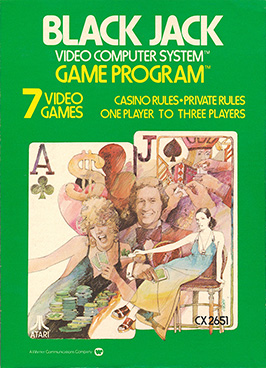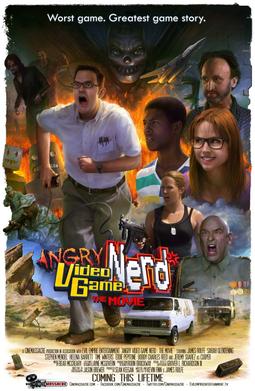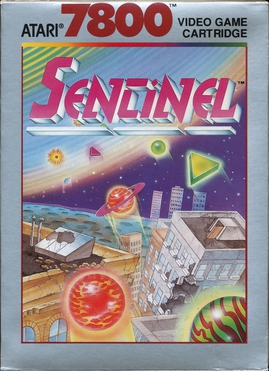
The Atari 2600 is a home video game console developed and produced by Atari, Inc. Released in September 1977 as the Atari Video Computer System, it popularized microprocessor-based hardware and games stored on swappable ROM cartridges, a format first used with the Fairchild Channel F in 1976. The VCS was bundled with two joystick controllers, a conjoined pair of paddle controllers, and a game cartridge—initially Combat and later Pac-Man. Sears sold the system as the Tele-Games Video Arcade. Atari rebranded the VCS as the Atari 2600 in November 1982 alongside the release of the Atari 5200.

E.T. the Extra-Terrestrial is a 1982 adventure video game developed and published by Atari, Inc. for the Atari 2600 and based on the film of the same name. The game's objective is to guide the eponymous character through various screens to collect three pieces of an interplanetary telephone that will allow him to contact his home planet.

Kaboom! is an action video game published in 1981 by Activision for the Atari 2600. The gameplay was based on the Atari arcade video game Avalanche (1978), with the game now involving a Mad Bomber who drops bombs instead of falling rocks. Kaboom! was programmed by Larry Kaplan with David Crane coding the graphics for the buckets and Mad Bomber. It was the last game designed by Kaplan for Activision, who left the company shortly after the release of the game. The game was later ported by Paul Wilson for the Atari 5200 system.

Star Raiders is a space combat simulator video game created by Doug Neubauer and published in 1980 by Atari, Inc. Originally released for the Atari 400/800 computers, Star Raiders was later ported to the Atari 2600, Atari 5200, and Atari ST. The player assumes the role of a starship fighter pilot, who must protect starbases from invading forces called Zylons. Piloting and combat are shown in the 3D cockpit view, while a 2D galactic map shows the state of the Zylon invasion. Neubauer made the game during in his spare time at Atari, inspired by contemporary media such as Battlestar Galactica and Star Wars, as well as the 1971 mainframe game Star Trek.

Solaris is a space combat video game for the Atari 2600 published in 1986 by Atari. The game involves a player seeking out the planet Solaris via their starship. To accomplish this, the player must navigate the galactic scanner to explore quadrants of a map. Doing so allows them to explore Federation planets to refuel their ship, and engage in combat with hostile aliens known as the Zylons.

Howard Scott Warshaw, also known as HSW, is an American psychotherapist and former game designer. He worked at Atari, Inc. in the early 1980s, where he designed and programmed the Atari 2600 games Yars' Revenge, Raiders of the Lost Ark, and E.T. the Extra-Terrestrial.

Phoenix is a fixed shooter video game developed for arcades in Japan and released in 1980 by Taito. The player controls a space ship shooting at incoming enemies that fly from the top of the screen down towards the player's ship. There are five stages which repeat endlessly. The fifth is a fight against a large enemy spaceship, making Phoenix one of the first shooters with a boss battle, an element that would become common for the genre.
1982 was the peak year for the golden age of arcade video games as well as the second generation of video game consoles. Many games were released that would spawn franchises, or at least sequels, including Dig Dug, Pole Position, Mr. Do!, Zaxxon, Q*bert, Time Pilot and Pitfall! The year's highest-grossing video game was Namco's arcade game Pac-Man, for the third year in a row, while the year's best-selling home system was the Atari 2600. Additional video game consoles added to a crowded market, notably the ColecoVision and Atari 5200. Troubles at Atari late in the year triggered the video game crash of 1983.

Alien is a 1982 maze video game for the Atari 2600 published by Fox Video Games. The game has the player control a human moving through the hallways of a space ship avoiding the adult alien and destroying the small alien eggs.

The Atari Flashback series are a line of dedicated video game consoles designed, produced, published and marketed by AtGames under license from Atari SA. The Flashback consoles are "plug-and-play" versions of the Atari 2600 console. They contain built-in games rather than using the ROM cartridges utilized by the 2600. Most of the games are classics that were previously released for the 2600, although some Flashback consoles include previously unreleased prototype games as well.

In the history of video games, the second-generation era refers to computer and video games, video game consoles, and handheld video game consoles available from 1976 to 1992. Notable platforms of the second generation include the Fairchild Channel F, Atari 2600, Intellivision, Odyssey 2, and ColecoVision. The generation began in November 1976 with the release of the Fairchild Channel F. This was followed by the Atari 2600 in 1977, Magnavox Odyssey² in 1978, Intellivision in 1980 and then the Emerson Arcadia 2001, ColecoVision, Atari 5200, and Vectrex, all in 1982. By the end of the era, there were over 15 different consoles. It coincided with, and was partly fuelled by, the golden age of arcade video games. This peak era of popularity and innovation for the medium resulted in many games for second generation home consoles being ports of arcade games. Space Invaders, the first "killer app" arcade game to be ported, was released in 1980 for the Atari 2600, though earlier Atari-published arcade games were ported to the 2600 previously. Coleco packaged Nintendo's Donkey Kong with the ColecoVision when it was released in August 1982.

Blackjack is a video game simulation of the card game blackjack. It was designed by Bob Whitehead for the Atari Video Computer System. The game allows up to three players to play a variation of blackjack. Each player is given 200 chips where they can bet 1 to 25 of each round. The game ends for a player when they either run out of chips or earns 1000 chips or more.

Pac-Man is a 1982 maze video game developed and published by Atari, Inc. under official license by Namco, and an adaptation of the 1980 hit arcade game of the same name. The player controls the title character, who attempts to consume all of the wafers in a maze while avoiding four ghosts that pursue him. Eating flashing wafers at the corners of the screen causes the ghosts to temporarily turn blue and flee, allowing Pac-Man to eat them for bonus points. Once eaten, a ghost is reduced to a pair of eyes, which return to the center of the maze to be restored.

The Atari video game burial was a mass burial of unsold video game cartridges, consoles, and computers in a New Mexico landfill site undertaken by the American video game and home computer company Atari, Inc. in 1983. Before 2014, the goods buried were rumored to be unsold copies of E.T. the Extra-Terrestrial (1982), one of the largest commercial video game failures and often cited as one of the worst video games ever released, and the 1982 Atari 2600 port of Pac-Man, which was commercially successful but critically maligned.

Several video games and genres have been created as a result of the release of the film E.T. the Extra-Terrestrial based on the story and themes of the original game.

Angry Video Game Nerd: The Movie is a 2014 American independent science-fiction adventure comedy film written and directed by James Rolfe and Kevin Finn. It is based on the web series of the same name, also created by Rolfe, with himself as the lead character alongside Jeremy Suarez, Sarah Glendening, Stephen Mendel, Time Winters, Helena Barrett, David Dastmalchian, Robbie Rist, and Eddie Pepitone.

Data Age was a California-based video game company that developed and published titles for the Atari 2600 platform in the mid-1980s. Among their more well-known titles were Journey Escape and Frankenstein's Monster, both published in 1982. The company was founded by Martin Meeker and four other designers. The employed 35 people by December 1982.

Secret Quest is an action-adventure game developed by Axlon for the Atari 2600 and published by Atari Corporation in 1989. The player controls a humanoid character that fights monsters and gathers items on a series of space stations. It was one of the last cartridges released for the console and has a larger ROM capacity than most 2600 games plus a small amount of RAM. The box credits Nolan Bushnell for the game and includes his photo on both the front and back. According to Secret Quest programmer Steve DeFrisco, "Atari thought that his name would entice people to buy some more 2600 titles".

Sentinel is a 1990 video game developed by Imagineering and published by Atari for the Atari 2600. It is the only light gun game ever released for the Atari 2600 platform. It was re-released with improved graphics for the Atari 7800 in 1991.

















